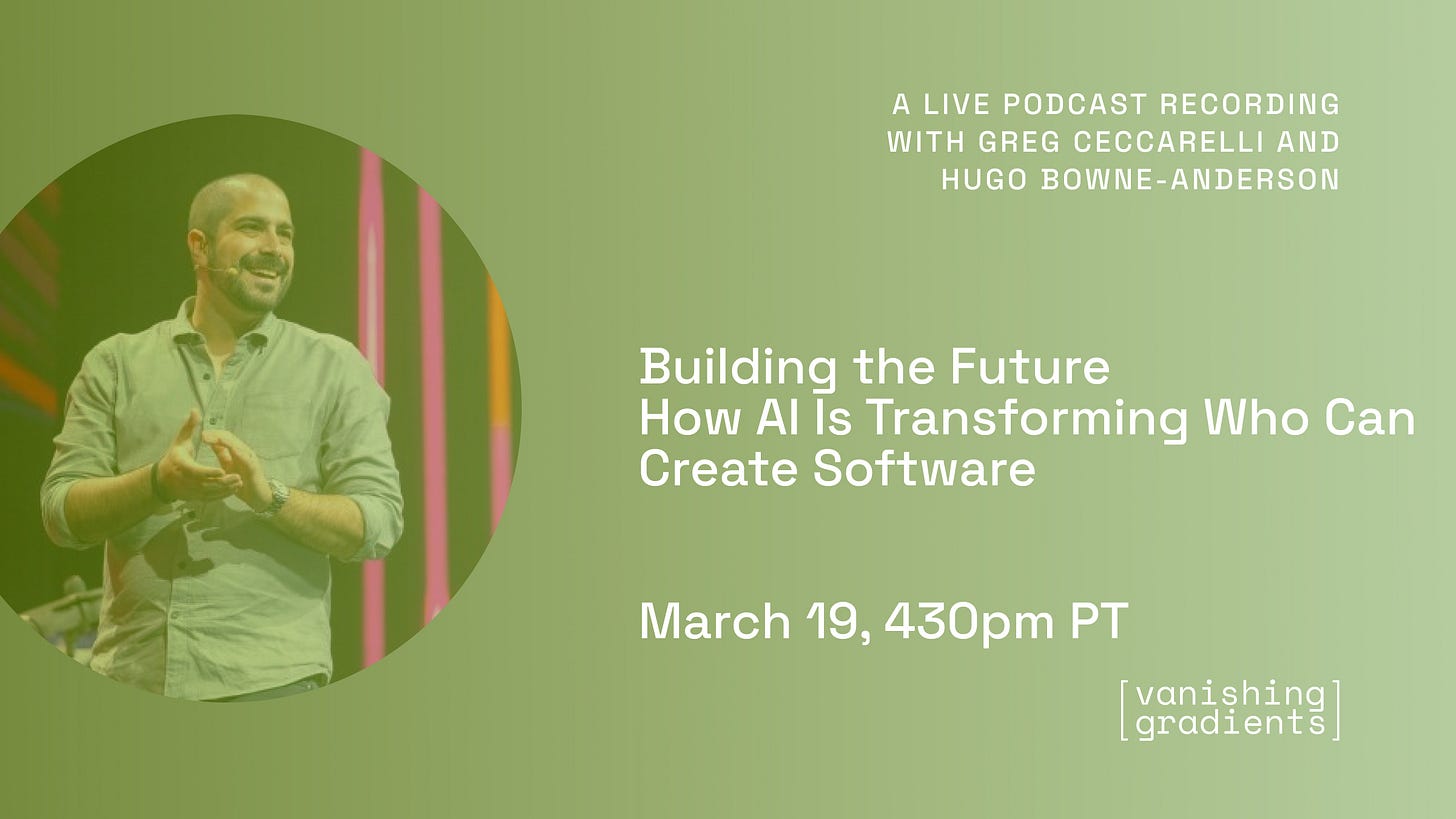Welcome back to Vanishing Gradients! This edition explores one of the most misunderstood aspects of AI and ML: when to keep it simple and when to go complex. From LLM agents to structured automation, we’re cutting through the noise to focus on practical, scalable AI workflows—the kind that actually work in production.
Here’s what’s inside:
🚀 Synthetic Data Flywheels: Catch AI Failures Before They Happen
🤖 When to Use LLM Agents (and When Not To): Why most AI agents add complexity without real value—and how to know when they’re worth it.
🛠️ Building AI Apps for Real-World Use Cases: Lessons from my workshop with Ravin Kumar (DeepMind) on moving from prototypes to production.
💡 From Idea to Working AI Tool—Overnight: How one offhand comment in our community turned into a real AI tool in less than 24 hours.
📚 Best Free Resources for Building AI Agents: A curated list of must-read guides, frameworks, and best practices to build reliable, scalable agentic systems.
📖 Reading time: 8-10 minutes
The theme? Building AI systems that actually work. Let’s get into it.
🚀 Synthetic Data Flywheels: Catch AI Failures Before They Happen
Most LLM teams don’t realize their app is broken until users start complaining. But what if you could simulate failures before they ever happen? That’s exactly what Synthetic Data Flywheels do. In this free 30-minute Lighting Lesson on April 1, Stefan Krawczyk and I will show you how to:
✅ Generate synthetic test cases to stress-test AI models
✅ Build an evaluation harness to catch failures before launch
✅ Create a continuous feedback loop to refine LLM behavior
P.S. If you're interested in LLM application testing, Stefan and I are also running a free Lightning Lesson on March 25 covering how to systematically test LLM outputs using pytest. If you want to write better tests, catch failures earlier, and improve app reliability, sign up here.
🚀 Building AI Apps for Real-World Use Cases: From Basics to Production
Last week, I hosted a livestream workshop with Ravin Kumar from DeepMind on taking AI applications from prototypes to production—covering everything from classification systems to systematic evaluation and optimization.
We tackled:
✅ Building an LLM-powered classification system
✅ Running zero-shot learning and evaluating model performance
✅ Moving beyond vibes-based testing to systematic evaluation
✅ Optimizing inference for speed, cost, and accuracy
Along the way, we explored error analysis, prompt iteration, and data flywheels, all while building with Gemma 2, Ollama, and Gradio.
📺 Watch the full workshop replay here.
Breakdown of Topics We Covered
What’s the biggest challenge you face when taking an LLM prototype to production? Reply and let me know!
💡 From Idea to Working AI Tool—Overnight
One of the most exciting moments from the workshop with Ravin Kumar wasn’t just what we built—it was what happened after.
During the session, we built an app using Gemma locally with Ollama, added a Gradio UI, logged results with SQLite, and monitored data with Datasette.
But what really stood out? Someone in our Discord community took an offhand idea—comparing multiple AI models side by side—and built a working tool the very next day. ✨
This is what makes AI so exciting right now: Ideas turn into real, functional tools fast.
📺 Watch the demo here:
Shoutout to Madhurima Chakraborty (CS PhD Candidate @ UC Riverside) for making it happen! And check out the code here 🚀
💡 What Comes After Code? The Role of Engineers in an AI-Driven Future
In the latest High Signal podcast, I sat down with Peter Wang—Chief AI Officer at Anaconda, Inc. and a driving force behind PyData—to discuss the shifting role of engineers in an AI-driven world.
Some key takeaways:
⚡ AI is eroding the value of coding as a skill—but making system design more critical than ever.
🔍 Businesses fixate on models when they should be focusing on integration.
🏗️ Software engineering is evolving from execution to debugging emergent behavior.
❌ We don’t need AI models for everything—often, better retrieval beats generation.🛠️ Stop expecting models to be “correct”—instead, design workflows that embrace uncertainty.
Peter has been a friend, collaborator, and mentor for nearly a decade, and every conversation with him shifts how I think about AI, software, and engineering. This one is no exception.
📺 Watch the clip below.
🎧 Listen to the full episode here.
🤖 When to Use LLM Agents (and When Not To)
LLM agents are everywhere—but do you actually need them?
If you’re just working with text, use an LLM.If you need external tools, use an augmented LLM.If you want the LLM to control workflows, use an agent—but buyer beware.
In my Lightning Lesson on Maven, I broke down when AI agents provide real value—and when they just add unnecessary complexity. What You’ll Learn:
⚡ When LLM agents are useful—and when they aren’t.
⚡ How to structure agentic workflows with external tools.
⚡ Debugging and evaluating agentic systems for reliability.
Agents sound powerful, but they introduce orchestration, debugging, and observability challenges that most teams don’t anticipate. This session cuts through the hype to help you make informed decisions about when to build with agents—and when simpler solutions will serve you better.
🛠️ Best Free Resources for Building AI Agents
I put together this handpicked list of free resources to help people ramp up for my Building LLM Apps course. But I realized it could be useful for a much broader audience—so I’m sharing it here.
This list covers agent design, planning, tool use, and failure modes—helping you move beyond basic prompt engineering to build more reliable AI-powered agents.
🚀 What’s inside?
🔍 Best practices for designing AI agents
🛠️ When to use tools, memory, and workflows
⚠️ Common pitfalls (and how to avoid them)
📚 Featured resources & authors:
Building Effective Agents – Erik Schluntz, Barry Zhang (Anthropic)→ Best practices for designing AI agents, emphasizing simple, composable patterns over complex frameworks. Covers when to use workflows vs. agents, how to enhance LLMs with tools and memory, and common pitfalls.
Agents – Chip Huyen→ Breaks down what makes an AI agent effective, focusing on tool selection, planning capabilities, and failure modes. Explores whether LLMs can plan and how to augment their reasoning to improve autonomy.
Agents – Julia Wiesinger, Patrick Marlow, Vladimir Vuskovic (Google)→ Explores how AI agents integrate reasoning, logic, and external information to improve decision-making and autonomy. Provides a structured approach to designing agents, covering tool use, planning, and failure modes relevant to real-world applications.
Introducing smolagents – Aymeric Roucher, Merve Noyan, Thomas Wolf (Hugging Face)→ Covers what AI agents are, when they should (and shouldn’t) be used, and how code-based agents function. Introduces smolagents, a minimalistic library for implementing multi-step agentic workflows with LLMs.
Beyond Prompt and Pray – Hugo Bowne-Anderson, Alan Nichol→ Argues that prompting alone isn’t enough for building reliable AI systems. Highlights real-world challenges in deploying LLM-powered systems and emphasizes evaluations, feedback loops, and deeper integrations as key to moving beyond naive prompt engineering.
📖 Get the full resource list here.
The best part?👉 It’s completely free—no paywalls, no subscriptions, just great content to explore.
💡 What’s your favorite resource on AI agents? Reply and let me know!
📅 Upcoming Events
1️⃣ Building the Future: How AI is Transforming Who Can Create Software
Date: March 13, 2025
Time: 4pm PT
Description: Join Greg Ceccarelli (Spec Story, formerly CPO at Plurasight & Director of Data Science at Github) and me as we discuss how AI-assisted development is enabling a new generation of creators to build software without traditional coding.
2️⃣Benchmarking AGI: Measuring Intelligence vs. Memorization with Greg Kamradt
Date: April 17, 2025
Time: 5pm PT
Description: Explore the challenges of evaluating artificial intelligence and the launch of the ARC Prize competition with Greg Kamradt.
Want to Support Vanishing Gradients?
If you’ve been enjoying Vanishing Gradients and want to support my work, here are a few ways to do so:
🎓 Cohort 2 of Building LLM Applications is now open! – The first run was a blast—over 80 students from Meta, Adobe, TikTok, Ford, and the US Air Force joined. The Discord community has been incredibly active, and we’ve had guest speakers like Hamel Husain, Swyx, Ravin Kumar (DeepMind), Eric Ma (Moderna), and Xharmagne Carandang (Lorikeet).
If you’re interested in joining the next cohort (or know someone who might be), check it out here. Also, hit reply if a group discount would be of interest!
📺 Watch the latest Lightning Lesson – If you missed LLM Agents: When to Use Them (and When Not To), you can watch the full recording here.
📢 Spread the word – If you find this newsletter valuable, share it with a friend, colleague, or your team. More thoughtful readers = better conversations.
📅 Stay in the loop – Subscribe to the Vanishing Gradients calendar on lu.ma to get notified about livestreams, workshops, and events.
▶️ Subscribe to the YouTube channel – Get full episodes, livestreams, and AI deep dives. Subscribe here.
💡 Work with me – I help teams navigate AI, data, and ML strategy. If your company needs guidance, feel free to reach out by hitting reply.
Thanks for reading Vanishing Gradients!
If you’re enjoying it, consider sharing it, dropping a comment, or giving it a like—it helps more people find it.
Until next time,
Hugo







